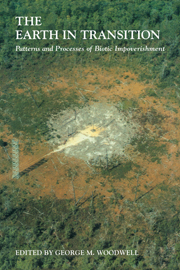Book contents
- Frontmatter
- Contents
- Preface
- Acknowledgments
- List of Contributors
- Part I Global Change and the Patterns of Impoverishment
- Part II Chronic Disturbance and Natural Ecosystems: Forests
- Part III Chronic Disturbance and Natural Ecosystems: Woodlands, Grasslands, and Tundra
- Part IV Chronic Disturbance and Natural Ecosystems: Aquatic and Emergent Ecosystems
- 18 Changes in a Red Sea Coral Community Structure: A Long-Term Case History Study
- 19 Are Deep-Sea Communities Resilient?
- 20 Species Dominance–Diversity Patterns in Oceanic Communities
- 21 Natural and Anthropogenically Imposed Limitations to Biotic Richness in Fresh Waters
- 22 Human Impacts on the South Florida Wetlands: The Everglades and Big Cypress Swamp
- 23 The Impoverishment of Aquatic Communities by Smelter Activities near Sudbury, Canada
- 24 Biotic Impoverishment: Effects of Anthropogenic Stress
- Part V Conclusion: Steps toward a World That Runs Itself
- Name Index
- Subject Index
20 - Species Dominance–Diversity Patterns in Oceanic Communities
Published online by Cambridge University Press: 24 November 2009
- Frontmatter
- Contents
- Preface
- Acknowledgments
- List of Contributors
- Part I Global Change and the Patterns of Impoverishment
- Part II Chronic Disturbance and Natural Ecosystems: Forests
- Part III Chronic Disturbance and Natural Ecosystems: Woodlands, Grasslands, and Tundra
- Part IV Chronic Disturbance and Natural Ecosystems: Aquatic and Emergent Ecosystems
- 18 Changes in a Red Sea Coral Community Structure: A Long-Term Case History Study
- 19 Are Deep-Sea Communities Resilient?
- 20 Species Dominance–Diversity Patterns in Oceanic Communities
- 21 Natural and Anthropogenically Imposed Limitations to Biotic Richness in Fresh Waters
- 22 Human Impacts on the South Florida Wetlands: The Everglades and Big Cypress Swamp
- 23 The Impoverishment of Aquatic Communities by Smelter Activities near Sudbury, Canada
- 24 Biotic Impoverishment: Effects of Anthropogenic Stress
- Part V Conclusion: Steps toward a World That Runs Itself
- Name Index
- Subject Index
Summary
Editor's Note: The oceans cover two-thirds of the surface of the earth, support primary production variously estimated as one-third to more than one-half of the global total, have by far the largest fraction of the volume of an obviously finite biosphere, and support a diversity of living systems that is only now being revealed as new techniques of exploration are developed. The oceans are simultaneously accumulating disturbance from human activities, even before the extent and role of life in the oceans have been defined. Disturbance includes the removal of fish, such as the tuna from the pelagic food-webs of the Pacific, and the accumulation of wastes, now pervasive. An ocean free of human influences is of the past.
The wastes are a nagging problem whose effects remain obscure, at least in the open ocean. Some of the wastes are dumped deliberately as sewage and other offal from cities such as New York and Boston and Rio and Athens. Some are industrial wastes such as the radioactivity dumped into the Irish Sea from the British reprocessing plant at Sellafield and into the Bay of Biscay by the French. Some are carried by the great rivers of the world, collected from cities and industries along their shores, and mixed into the sediments and waters of coastal regions globally, gradually to enter the complex circulation of the abyssal seas. Others are carried much less conspicuously to the oceans in air to be scrubbed from the atmosphere in rain.
- Type
- Chapter
- Information
- The Earth in TransitionPatterns and Processes of Biotic Impoverishment, pp. 395 - 424Publisher: Cambridge University PressPrint publication year: 1991



